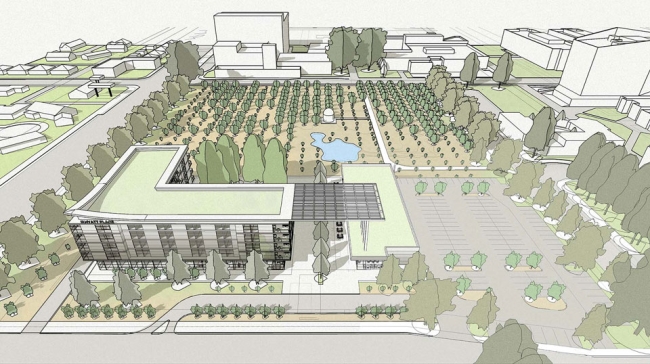You have /5 articles left.
Sign up for a free account or log in.

Cal State Northridge is planning a $52 million hotel project under a public-private partnership.
Cal State Northridge
WASHINGTON -- Public-private partnership models are continuing to proliferate as cash-strapped colleges and universities seek to replace or update aging and outdated infrastructure amid tight finances.
That proliferation is on display in many of the large development projects institutions announce, like the ambitious billion-dollar-plus campus expansion plan the University of California, Merced, unveiled last year that uses a public-private partnership to build and operate new facilities. And it was evident at the Society for College and University Planning’s annual conference in Washington this week, where several sessions focused on public-private partnerships, which are often called P3s.
Speakers pushed back against the idea that P3s are solely a way for colleges and universities to build when they have no debt capacity and little public financing available. Projects need to be viable on their own, and institution leaders should not expect P3s to be a source of facilities with no long-term financial impacts, speakers said.
“They kind of always start with the premise or this notion of ‘let’s keep it off our balance sheet,’” said Jeff Turner, executive vice president at the program management firm Brailsford & Dunlavey. “But when you dig a little deeper, that’s a little bit of a fallacy.”
Turner spoke at a session Wednesday examining the different models and best practices for P3s. It was one of several sessions addressing the P3 model, who is using it, how it is being used and how it is developing.
P3 models can be difficult to quantify because they take many different forms. Generally speaking in higher education, they have colleges and universities tapping private companies to finance, design, build operate and maintain facilities. The private companies don’t necessarily provide all of those services in each instance -- the services provided vary by situation. The exact legal structures of the deals vary as well.
Colleges and universities will often pay for the up-front services through decades-long contracts under which the private partners operate and maintain the new facilities or draw revenue that they generate.
The model stands in contrast to a traditional setup in which a college or university is responsible for financing a project up front or through bonds, hiring an architect and builder and operating a facility once it is finished.
P3s are probably best known in the United States as mechanisms for building dormitories. But the model has been migrating to other types of facilities in the last decade or so. Some say the migration has been driven by colleges and universities running into funding constraints from cash-strapped state governments and students who are balking at paying higher tuition and fees. But others see it as a way for institutions to pull off new types of development projects and tap private-sector financing without being saddled by operational headaches in the future.
One example of that is a Hyatt Place hotel planned for California State University, Northridge. The university has signed a letter of intent and is moving toward further agreements with a developer for the $52 million project, which is expected to be completed in 2019.
The hotel is planned to have about 150 rooms with a conference center and restaurant, said Colin Donahue, vice president of administration and finance at Cal State Northridge. Donahue spoke at the Wednesday session.
Cal State Northridge could have built the hotel on its own, Donahue said. But it had to look at long-term risks.
“One of the things I was really concerned about is the risk to our general fund,” Donahue said. “We’re not hotel operators. We’re good at a lot of things, but we’re not going to be nearly as efficient. We don’t understand that market. And so it was better for us to get into risk sharing by understanding the market.”
The hotel Cal State Northridge plans will have a 65-year ground lease. If all goes well, the developer will likely sell it in five years -- a standard move in the hotel industry, Donahue said. But that requires consideration as the university structures the deal. So does having a private operator on campus for 65 years.
Institutions need to approach the deals by planning for things that could go wrong, said Deborah Wylie, higher education studio leader at the architecture firm Harley Ellis Devereaux, who also spoke Wednesday.
“Keep in mind your relationship with your developer is 30, 60, 90 years,” she said. “Anybody been married for that long?”
Donahue said Cal State Northridge has brought in real estate advisory firms and outside lawyers focused on real estate for P3s. Lawyers with experience in real estate say P3s are the types of deals they’ve done their whole lives, he said. But universities don’t necessarily have experience in such deals.
The complexity of the deals means they aren’t necessarily cheaper over all than if a college or university built a facility using a traditional model. They aren’t necessarily built faster, either. But developers can be better at controlling costs during and after the construction process, Turner said. Deals that include long-term operating agreements can mean private companies hire employees to staff buildings, a cheaper proposition than hiring state employees who receive more generous benefits.
Developers tend to invest more in buildings over their lifetimes than do universities, Donahue said. The private sector is in the habit of building cash reserves and updating buildings on a 10-year cycle. Universities can be tempted to defer maintenance as they address other budget priorities.
Some interesting developments at the system in California could ease P3 development.
The University of California has prequalified eight firms for student housing, Wylie said. UC campuses can tap into that list and avoid having to do separate requests for qualifications.
Cal State, meanwhile, is attempting to pool shared experiences from P3s across its campuses and make its processes more consistent, Donahue said.
“What we’re trying to do now is pull together our shared experiences and develop some agreement templates and take some of the best practices that we’ve seen, look at things like the way you would analyze a project through the negotiations as the terms change,” he said. “We want to be known in the development community as a system that has our act together and is attractive to work with.”
Turner is seeing more and more bundling of multiple facilities into large P3 projects, he said. He warned against being overly ambitious with such projects. Donahue said he believes opportunity exists in smaller P3s.
The Wednesday presentation came a day after another notable session in which Nic de Salaberry, the director of planning and development at Ryerson University in Toronto, shared an analysis of P3s. He used a SCUP fellowship to study P3s and their application in higher education.
He found that P3s are creating options for long-term planning at universities and that the model is adaptable. But de Salaberry also found the model is better suited for some projects than it is for others.
“I’m an optimist -- I like to think that as more P3 projects are built for higher learning, there will be more lessons shared and more scrutiny of results,” he said. “However, I’m also a realist, and because the money has to come from somewhere, there is only so much that a P3 solution can do to address long-term questions of how our campuses will be renewed.”
P3s often mean less risk for colleges and universities seeking to build. But they also mean less control over the projects. As a result, de Salaberry believes the model is better suited for non-core university functions like student housing than it is for core functions like classrooms and laboratories, over which institutions likely want more control.
While P3s can open new sources of funding for colleges and universities, they can also influence the way institutions develop. One example de Salaberry gave was a design-build-finance P3 used to build a 365,000-square-foot aquatics center and gym for the 2015 Pan American Games in Toronto. The project, which cost 205 million Canadian dollars -- or about $160 million -- was led by a public agency. It took the specifications from the University of Toronto at Scarborough and the city of Toronto, which were slated as its long-term users.
Projects that received funds for the Pan Am games were bumped ahead of other projects their home institutions might have viewed with a higher priority, de Salaberry said.
“You might just see that as funding priorities, and it is,” he said. “But it’s also a result of the P3 model that they could even have that bumping up take place.”
Looking forward, de Salaberry wondered how P3 models and the facilities they create will stand the test of time. He wonders how the facilities will age -- whether buildings with multiyear private maintenance agreements will be maintained better than those that are owned and maintained by higher education institutions.
UC Merced will be an interesting test case for that.
“Half their campus is less than 10 years old and it was built in a conventional way,” de Salaberry said. “The other half will have that long-term operating contract. It will be fascinating to go to Merced in 20 years and see whether there is a difference on one side of the campus versus the other.”
He suspects colleges and universities in urban areas will be able to attract more interest from developers and stronger sets of bids than those in rural areas. And he pointed out that some information on P3 performance may be hard to come by -- institutions often don’t always like to talk about projects that fail to live up to expectations.
“For me, the biggest takeaway is that P3s are not like some magic bullet,” de Salaberry said. “They’re not solving all the problems of universities, but they are showing us what universities think is most important to them.”




